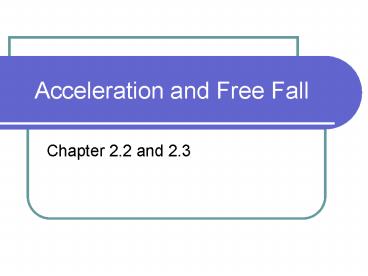Acceleration and Free Fall PowerPoint PPT Presentation
1 / 34
Title: Acceleration and Free Fall
1
Acceleration and Free Fall
- Chapter 2.2 and 2.3
2
What is acceleration?
- Acceleration measures the rate of change in
velocity. - Average acceleration change in velocity/ time
required for change
3
Units for acceleration
4
Sign is very important!
- Acceleration has both direction and magnitude
- A negative value for acceleration does not always
mean an object is decelerating!!
5
2-4 Acceleration
Increasing speed and deceleration (decreasing
speed) should not be confused with the directions
of velocity and acceleration
Slowing down, moving to the right
Speeding up, moving to the right
Speeding up, moving to the left
Slowing down, moving to the left
6
Fill in the Chart
Initial Velocity Acceleration Motion
Speeding up, moving right/up
- - Speeding up, moving left/down
- Slowing Down moving right/up
- Slowing Down, moving left/down
- or 0 Constant Velocity
0 - or Speeding up from rest
0 0 Remaining at rest
7
Graph of Velocity vs Time
Question What does the slope of this graph give
you?
Answer ACCELERATION
Rise ?v Run ?t
Vf VAVG ?v
tf ti ?t
8
- The Kinematic Equations
- You are going to loooooove these! ?
9
Motion with constant acceleration
- Kinematic Equations
- The relationships between displacement, velocity
and constant acceleration are expressed by
equations that apply to any object moving with
constant acceleration.
10
Displacement with constant acceleration
- ?x displacement
- Vi initial velocity
- Vf final velocity
- ?t time interval
11
Example 1 p.53 in book
- A car accelerates uniformly from rest to a speed
of 23.7 km/h in 6.5 s. Find the distance the car
travels during this time. - ?x displacement distance ?
- Vi initial velocity rest 0 km/h
- Vf final velocity 23.7 km/h
- ?t time interval 6.5 s
Look at final velocityconvert to m/s!!!
12
Problem Solving
- Final velocity
- conversion
- Plug in values and solve for ?x
13
Velocity with constant uniform acceleration
Vf final velocity Vi initial velocity a
acceleration ?t time interval
14
Example 2 p.55
- An automobile with an initial speed of 4.30 m/s
accelerates uniformly at the rate of 3.0 m/s2.
Find the final speed after 5.0 seconds.
Vf final velocity? Vi initial velocity
4.3 m/s a acceleration 3.0 m/s2 ?t time
interval 5.0 s
15
Solve
- Plug in values and solve for Vf
- Vf 19 m/s
16
Displacement with constant uniform acceleration
?x displacement Vi initial velocity a
acceleration ?t time interval
17
Example 2 p.55
- An automobile with an initial speed of 4.30 m/s
accelerates uniformly at the rate of 3.0 m/s2.
Find the displacement after 5.0 seconds. - ?x displacement??
- Vi initial velocity 4.30 m/s
- a acceleration 3.0 m/s2
- ?t time interval 5.0 s
18
Solve!
- Plug in values and solve for displacement
19
Final Velocity after any displacement
Vf final velocity Vi initial velocity a
acceleration ?x displacement
20
Example p.58 3
- A car accelerates uniformly in a straight line
from rest at the rate of 2.3 m/s2. What is the
speed of the car after it has traveled 55 m? - Vf final velocity??
- Vi initial velocity rest 0 m/s
- a acceleration 2.3 m/s2
- ?x displacement 55 m
21
Solve
22
Rearranging
- Your problems wont always be so
straightforwardmake sure to rearrange your
equations to solve for the unknown before
plugging in your numbers (with units!)
23
Section 2-3 Falling Objects
- Free Fall Neglecting air resistance, all objects
fall with the same constant acceleration
24
Acceleration due to gravity
25
Free Fall Acceleration
- However, acceleration is a vector.
- Gravity acts toward the earth (down)
- Therefore, the acceleration of objects in free
fall near the surface of the earth is
26
What we see because of air resistance
27
Object falling from rest
28
Path of a projectile
At top of path v 0 m/s a -9.81 m/s2
29
Free Fall Acceleration
- At the highest point of an arc, an object has
velocity 0 m/s, acceleration is still -9.81
m/s2 - An object thrown into the air is a freely falling
body with
30
Free Fall Problem p.64 2
- A flowerpot falls from a windowsill 25.0 m above
the sidewalk - A. How fast is the flowerpot moving when it
strikes the ground? - B. How much time does a paserby on the sidewalk
below have to move out of the way before the
flowerpot hits the ground?
31
Part. A.
- What are we looking for Vf
- What do we know?
- Displacement -25 m
- Acceleration -9.81 m/s2
- Vi0 m/s
- What equation should we use??
32
Solve the problem ?
33
Part b.
- How much time before the flowerpot hits the
ground? - What do we know?
- Displacement -25.0 m
- Acceleration -9.81 m/s2
- V initial 0
- V final -22.1 m/s
- What are we looking for Time!
- Which equation should we use??
34
Solve the Problem ?

